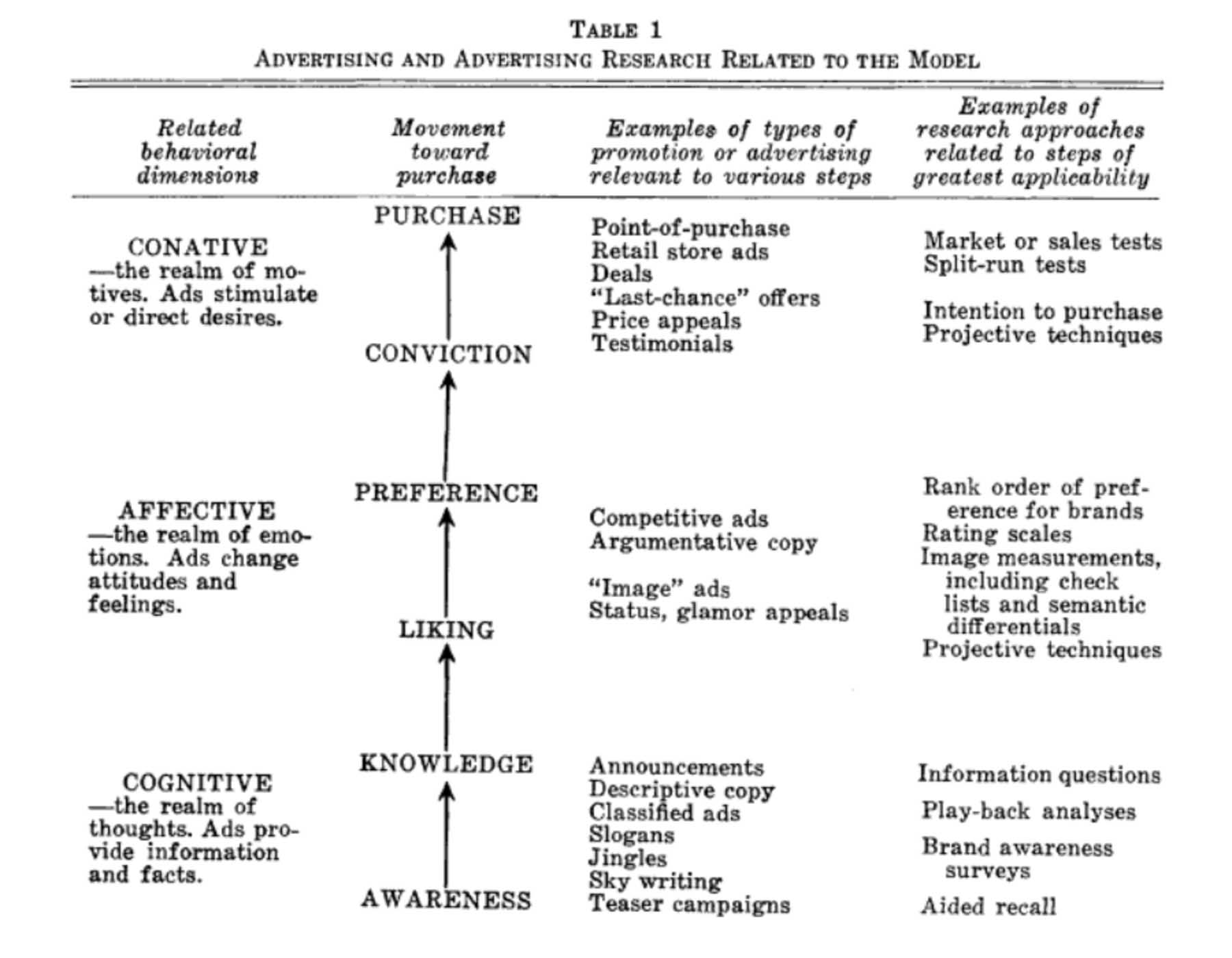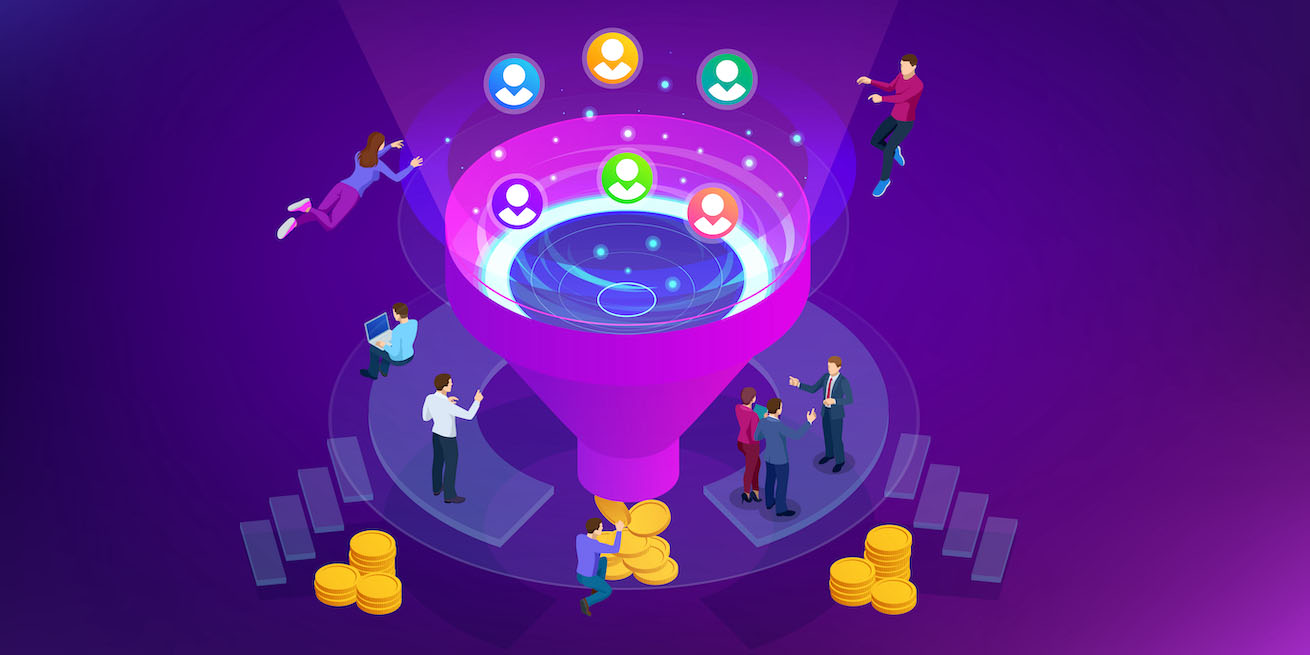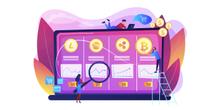There’s your business and there’s your target audience.
You’ve always suspected there’s something else between them, a hidden place where conversions have minds of their own until you discover that someone completes them.
Every conversion is a cipher that leaves behind tracks. And if you know how to follow them, you’ll know basically everything you need to improve how you run your business and make it successful.
In this blog post, we’ll go down the rabbit hole and dive deeper into the marketing funnel as a concept in order to help you build the right model with the correct order of marketing funnel stages.
Before learning about marketing funnel stages, let’s figure out one thing:
Why did salespeople start using funnels?
AIDA — The Very First Marketing Funnel Stages
A funnel is a perfect way to depict the interactions between customers and a business. William W. Townsend, an American bond sales manager, was the first person to envision this.
In his book Bond Salesmanship, published in 1924, Townsend uses the AIDA model invented by American advertising advocate E. St. Elmo Lewis in 1898 to offer a funnel as a way to visualize the customer’s journey.
What are the stages of this marketing funnel model?
The AIDA model includes the very first sales and marketing funnel stages in history:
- Attention or Awareness — The business catches the customer’s eye.
- Interest — The business awakens the customer’s desire.
- Desire — The business transforms the customer’s desire into aspiration.
- Action — The business convinces the customer to become a buyer.
These four stages are the starting point in the evolution of marketing funnels.
With time, the AIDA model received lots of modifications and gave birth to other models that pushed the funnel evolution forward.
The Hierarchy of Effects — Funnel Stages and Psychology
A great example of funnel stages in marketing can be found in an upgraded AIDA model that appeared in the October 1961 issue of the Journal of Marketing.
In the article “A Model for Predictive Measurements of Advertising Effectiveness,” marketing researcher Robert J. Lavidge and associate professor of psychology Gary A. Steiner propose a model that later became famous as the Hierarchy of Effects.

This model includes six steps organized according to the functions of common advertising and research approaches:
- Awareness — The purchaser is partly aware or completely unaware of the product’s or service’s existence.
- Knowledge — The purchaser knows what the product or service has to offer.
- Liking — The purchaser has favorable attitudes toward the product or service.
- Preference — The purchaser has developed favorable attitudes to the point of preferring the product or service over all other possibilities.
- Conviction — The purchaser couples this preference with a desire to buy and the conviction that the purchase would be wise.
- Purchase — The purchaser translates this attitude into an actual purchase.
The Hierarchy of Effects model is curious not only because it has pretty much the same sequence of stages as the sequence of digital marketing funnel stages marketers use these days but also because of three behavioral dimensions that determine these stages from the psychological perspective.
- In the cognitive dimension, or the realm of thoughts, which incorporates the awareness and knowledge stages and is characterized by the intellectual, mental, and rational states of mind, ads provide information and facts.
- In the affective dimension, or the realm of emotions, which incorporates the liking and preference stages and is characterized by emotional states, ads change attitudes and feelings.
- In the cognitive dimension, or the realm of motives, which incorporates the conviction and purchase stages and is characterized by striving related to the tendency of people to treat objects as positive and negative goals, ads stimulate or direct desires.
Not to mention that the Hierarchy of Effects was one of the first models to demonstrate what kinds of content advertisers should use at different funnel stages — one of the biggest concerns in today’s marketing.
TOFU, MOFU, BOFU — Inbound Marketing Funnel Stages
At the next stage of the evolution of funnel stages, marketing went digital.
With the advent of the internet, traditional outbound marketing such as television commercials, radio ads, printed ads, email newsletters, and cold calls went into the background.
Instead of dictating the customer’s journey, businesses had no choice but to adjust to the actual journey using inbound marketing funnel stages — TOFU, MOFU, and BOFU — that lure customers through the search engine optimization (SEO) of a website, blog, social media channel, or content advertising.
TOFU, MOFU, and BOFU are acronyms that stand for the top of the funnel, middle of the funnel, and bottom of the funnel. Based on the same concept as AIDA and the Hierarchy of Effects, TOFU, MOFU, and BOFU represent the awareness, interest, and conversion stages, respectively.
Let’s see how this funnel works at each stage.
Top of the Funnel (TOFU) — Awareness
At the top of the funnel, your goal is to make your business noticeable and generate leads. After you reach your leads, your priority isn’t promotion but enlightenment.
Here are the major ways of attracting leads at the top of the funnel:
- SEO. Search engine optimization is the first thing to do for your website when you launch it. By making your website content Google-friendly, you also make it friendly to your website audience which, eventually, will give you a better understanding of how to effectively guide users through your digital marketing funnel stages.
- Blogging. Creating a blog on your website and writing articles on various topics is the best way to attract leads organically and grow your SEO ranking.
- Guest posting. Writing articles with backlinks to your website and offering other blogs to post them is another good point for your website’s SEO that will let you lure more people to your business.
- Outreach marketing. Contact other websites, bloggers, and influencers related to your business to collaborate and get more traffic for free.
- Paid ads. Along with growing your website traffic organically, you can use Google Ads and Facebook Ads Manager to run paid advertising across the world’s top search engines and social media channels.
- Posting on Facebook and Instagram. These social media channels are free and very effective when used wisely.
- YouTube channel. The world’s top video sharing platform offers viewers a great recommendation system that allows them to find content they want.
- TikTok videos. If you decide to create a YouTube channel, consider TikTok advertising as an alternative because it’s the fastest-growing social media platform of 2020.
Middle of the Funnel (MOFU) — Interest
In the middle of the funnel, your goal is to earn the trust of your leads and let them understand that your business or brand has a real way of solving their problems. After you attract leads, your priority is to introduce them to the major benefits you offer over your competitors.
You can do that with:
- Webinars. Meet with your leads online to show the solution in real time.
- Tutorials. Provide guidance in written form on your blog or elsewhere.
- Comparisons. Match your product or service features with features of your rivals by creating an article, video, or infographic.
- Case Studies. Tell stories of your customers and how your business has assisted them.
Bottom of the Funnel (BOFU) — Conversion
At the bottom of the funnel, your goal is to encourage leads to buy products or services by showing how exactly your business or brand can solve their issues. After leads transform into customers, your priority is to transform them into regular customers and nurture relationships with them.
Here are examples of how to convert and nurture customers at the bottom of the funnel:
- Free trial period. Let people test your product or service for themselves.
- Sales and promo codes. Offer specials and discounts.
- Giveaways. Start a contest and give your product or service free of charge.
- Live support. Provide 24/7 assistance via email and live chat.
- Insights. Ask leads and customers to take part in research or a survey and demonstrate the results in the form of an article or infographic.
- Loyalty programs. Encourage customers to buy more with special deals.
- Email automation. Set up email automation to send emails to different groups of customers at the right time.
B2C vs B2B Marketing Funnel Stages
If your business offers products or services to other businesses, keep in mind that the difference between B2C and B2B marketing funnel stages is slight but significant.
At the top of the B2B funnel, you should get right to business. You already know that B2C customers buy emotions rather than products or services and want to be entertained before purchasing. B2B customers think rationally. They need information more than anything else — and in detail. More to the point, you should target multiple customers at once, not individually as you do in B2C funnels.
Since B2B customers value information, the methods of attracting customers in the middle of the B2B funnel are pretty much the same as in the middle of the B2C funnel. The major difference is that it takes much more time to move to the next stage because B2B relationships evolve over a long cycle.
How to Build the Right Funnel for Your Business
What is the correct order of marketing funnel stages for your business?
In today’s marketing, interactions between the customer and the business are totally different than they used to be. That’s why the funnel doesn’t work like it used to. Rather, it works like a wheel endlessly spinning around three stages we’ve already mentioned above: awareness, interest, and conversion.
The trick is that leads and customers can get on the wheel at any moment. Having read about different funnel models, you might have already guessed how to do the magic and get your marketing wheel to spin smoothly and in the right direction:
- Know your customers’ pain points.
- Learn customer behavior patterns.
- Have a pre-made content plan for each stage.
Finally, keep in mind that you should always keep a close watch on your marketing results in order to improve your model.
Use AI to Create Top-Notch Video Content for Any Funnel Stage
Video marketing is a great strategy to attract both prospects and customers no matter how well you know them or how well they know your business.
With Softcube, you’ll be able to make high-quality video content quickly and at a large scale for each stage of your marketing funnel.
Use artificial intelligence to crawl your listing pages and let the Softcube platform customize ready-made video templates with your text, logo, and brand colors.
Good luck building your funnel!



